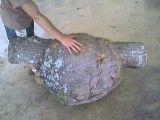Question
I cut down this oak burl in GA yesterday and would like to know if anyone has any good advice to give me about drying this out for turning on the lathe.

Forum Responses
(Sawing and Drying Forum)
From contributor R:
I like to turn when the wood is green. You can twice turn a bowl. That is, turn your bowl down to about 1" thick walls, pack the bowl in its own sawdust in a bag, and let it dry. The bowl will dry much faster. When it is where you like it, remount it and cut it back to round and to the wall thickness you like. Nice burl.
Turn a bowl or hollow form out of any piece of wood and place the pith in the center as a test. Make it consistently 3/16"-1/4" thick and then allow it to dry in the air for a few weeks. Come back and take a look. The pith may crack a bit, but that is expected for a few inches within its perimeter. Other than that, the piece will take on a football shape. Do the same with a burl (no pith likely) and there are so many possible shapes that can happen, it's amazing, from water ripple textures to large bumps. Some people turn green to achieve this affect. I love the effect of turning green and thin, but one of the major benefits is that it is so much easier to turn, and much more fun with the right tool.
The best tool for making bowls is the fingernail gind on a 1/2" or 5/8" bowl gouge, specifically David Ellsworth's version. It is the only tool you need for making basic bowls, and even complicated ones.